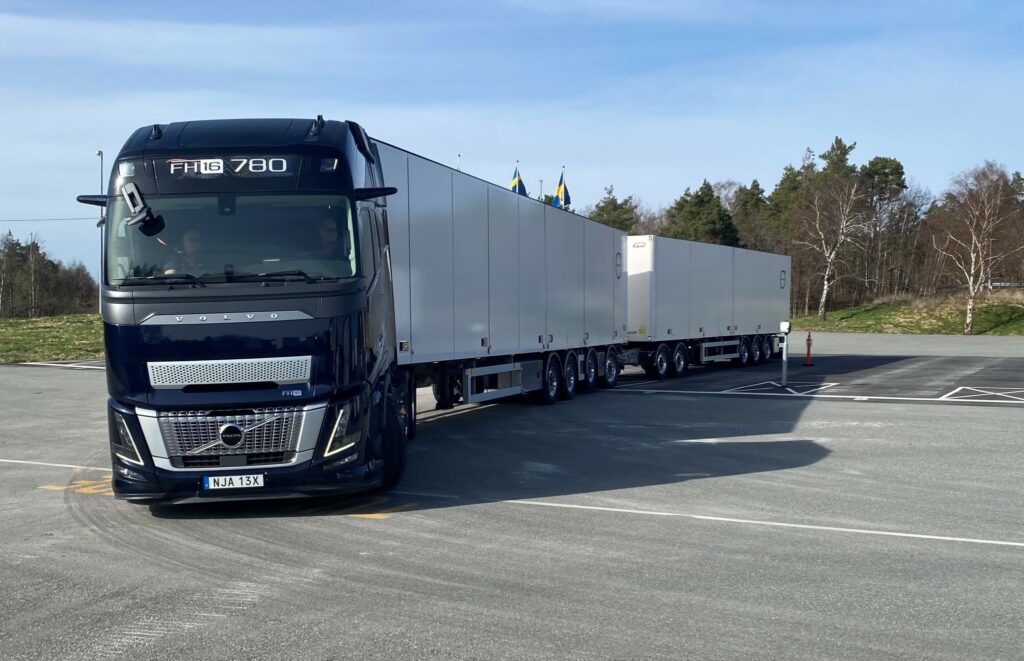Many roads point to zero emissions
Decarbonizing the trucking industry on our path to zero emissions can and will take on many different forms, including some that are counterintuitive, yet effective.
Take, for example, longer trailer combinations pulled by trucks with bigger, more powerful – yet more efficient – engines. I visited Volvo in Gothenburg, Sweden, in early April where I had the chance to take a short spin in a long truck – a 34.5-meter combination weighing 60 tons.

The dual-trailer combination was pulled by Volvo’s new FH16 Aero cabover tractor powered by a 780-hp, 2,212 lb.-ft. D17 engine. That’s the most powerful engine Volvo has ever produced for an on-highway truck, and the highest-horsepower engine offered in Europe.
Yet its introduction comes at a time when the industry, in both Europe and North America, is faced with aggressive emissions mandates that will eventually fully decarbonize the sector.
The 17-liter engine, believe it or not, is more efficient than the lesser-powered engine it replaced. Volvo capitalized on improvements in engine design – including its patented wave piston – and introduced more engine braking power at low engine speeds for smoother operation. It also reduced weight from the engine.
Focus on freight efficiency
There are no plans to bring the D17 to the North American market, but the learnings from its introduction to the Swedish market can and should be brought here, and that is that we need to keep an open mind about decarbonization on the path to zero emissions. Yes, bigger, more powerful truck combinations are an effective way to slash freight emissions, when viewed through the lens of overall freight efficiency.
We are pretty good at this in Canada. The use of long combination vehicles – one tractor pulling two 53-ft. trailers – has expanded in recent years and the operators of these longer combinations have proven capable of doing so safely.
The same is true overseas. Volvo has spent years proving to a skeptical public that longer truck combinations are safe. “There are tremendous benefits with bigger vehicle combinations,” Lars Martensson, environment and innovation director with Volvo Trucks told us.
Bigger can be safer
Six tractors pulling six single trailers, each with an overall length of 16.5 meters, could be replaced by three FH16 780 Aeros each pulling two trailers with overall lengths of 34 meters and the result would be a 27% reduction in Co2 emissions. That equipment would also occupy 40% less space, contributing to reduced congestion and fewer trucks equating to improved highway safety.
Sweden, is of course, moving cautiously toward allowing these longer combinations. It has approved their use on just 5,900 km of the nation’s 100,000 km road network. But, says Martensson, these are the roads with the greatest benefits, which connect larger cities and extend up the coast where there’s an abundance of heavy industry.
The journey ahead
The point of all this is to say, decarboninzation is a journey, not a switch to be flipped. And there are many paths to getting there. Some, such as operating bigger, more powerful truck and trailer combinations, are counterintuitive, but shouldn’t be dismissed.
Regulators can easily fall into the trap of developing tunnel vision and fixating on a single technology that’s easy to understand because, well, their neighbor drivers a Tesla and loves it!
Yes, electric vehicles will have a major role to play in decarbonizing trucking, yet they won’t be viable in every application or region. This is where the ingenuity and expertise of truck makers must be heavily leaned upon to develop the best solutions, including the ones we wouldn’t necessarily think of, such as larger, more powerful engines and longer trailer combinations.
Lars Stenqvist, Volvo Trucks’ chief technology officer, summed it up for us in a later discussion on the same trip.
“There are too many politicians across the globe who are a little too trigger-happy and want to ban technologies instead of telling us what they want to achieve. Tell us what you want to achieve,” he implored.
“I have 15,000 engineers – they will develop the best technology. Don’t ban technology.”
Have your say
This is a moderated forum. Comments will no longer be published unless they are accompanied by a first and last name and a verifiable email address. (Today's Trucking will not publish or share the email address.) Profane language and content deemed to be libelous, racist, or threatening in nature will not be published under any circumstances.
Nothing new here.
Just go to Australia and look at the multi trailer trains they have had in service for years.
Two trailers would be nothing in Australia.
Comparing a very small country like Sweden to Canada or the United States is not a good comparison.
Bigger is not safer in construction zones or in heavy traffic in places like Toronto and Vancouver
I do agree large cabovers like that volvo should be able to come in but only with weight saving items like aluminum frames aluminum wheels and carbon fiber cabs and liituim batteries to reduce the need to run the engine for hotel loads